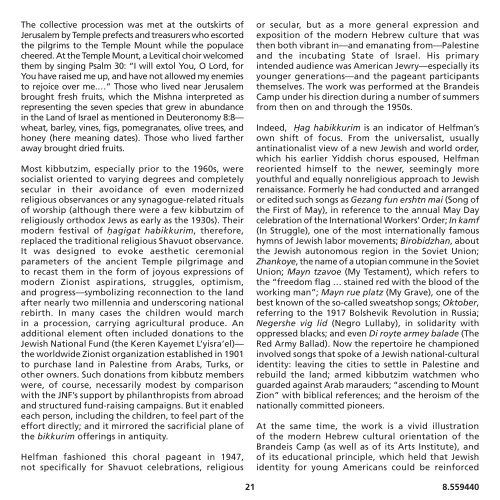Download Liner Notes PDF - Milken Archive of Jewish Music
Download Liner Notes PDF - Milken Archive of Jewish Music
Download Liner Notes PDF - Milken Archive of Jewish Music
You also want an ePaper? Increase the reach of your titles
YUMPU automatically turns print PDFs into web optimized ePapers that Google loves.
The collective procession was met at the outskirts <strong>of</strong><br />
Jerusalem by Temple prefects and treasurers who escorted<br />
the pilgrims to the Temple Mount while the populace<br />
cheered. At the Temple Mount, a Levitical choir welcomed<br />
them by singing Psalm 30: “I will extol You, O Lord, for<br />
You have raised me up, and have not allowed my enemies<br />
to rejoice over me.…” Those who lived near Jerusalem<br />
brought fresh fruits, which the Mishna interpreted as<br />
representing the seven species that grew in abundance<br />
in the Land <strong>of</strong> Israel as mentioned in Deuteronomy 8:8—<br />
wheat, barley, vines, figs, pomegranates, olive trees, and<br />
honey (here meaning dates). Those who lived farther<br />
away brought dried fruits.<br />
Most kibbutzim, especially prior to the 1960s, were<br />
socialist oriented to varying degrees and completely<br />
secular in their avoidance <strong>of</strong> even modernized<br />
religious observances or any synagogue-related rituals<br />
<strong>of</strong> worship (although there were a few kibbutzim <strong>of</strong><br />
religiously orthodox Jews as early as the 1930s). Their<br />
modern festival <strong>of</strong> ḥagigat habikkurim, therefore,<br />
replaced the traditional religious Shavuot observance.<br />
It was designed to evoke aesthetic ceremonial<br />
parameters <strong>of</strong> the ancient Temple pilgrimage and<br />
to recast them in the form <strong>of</strong> joyous expressions <strong>of</strong><br />
modern Zionist aspirations, struggles, optimism,<br />
and progress—symbolizing reconnection to the land<br />
after nearly two millennia and underscoring national<br />
rebirth. In many cases the children would march<br />
in a procession, carrying agricultural produce. An<br />
additional element <strong>of</strong>ten included donations to the<br />
<strong>Jewish</strong> National Fund (the Keren Kayemet L’yisra’el)—<br />
the worldwide Zionist organization established in 1901<br />
to purchase land in Palestine from Arabs, Turks, or<br />
other owners. Such donations from kibbutz members<br />
were, <strong>of</strong> course, necessarily modest by comparison<br />
with the JNF’s support by philanthropists from abroad<br />
and structured fund-raising campaigns. But it enabled<br />
each person, including the children, to feel part <strong>of</strong> the<br />
effort directly; and it mirrored the sacrificial plane <strong>of</strong><br />
the bikkurim <strong>of</strong>ferings in antiquity.<br />
Helfman fashioned this choral pageant in 1947,<br />
not specifically for Shavuot celebrations, religious<br />
or secular, but as a more general expression and<br />
exposition <strong>of</strong> the modern Hebrew culture that was<br />
then both vibrant in—and emanating from—Palestine<br />
and the incubating State <strong>of</strong> Israel. His primary<br />
intended audience was American Jewry—especially its<br />
younger generations—and the pageant participants<br />
themselves. The work was performed at the Brandeis<br />
Camp under his direction during a number <strong>of</strong> summers<br />
from then on and through the 1950s.<br />
Indeed, Ḥag habikkurim is an indicator <strong>of</strong> Helfman’s<br />
own shift <strong>of</strong> focus. From the universalist, usually<br />
antinationalist view <strong>of</strong> a new <strong>Jewish</strong> and world order,<br />
which his earlier Yiddish chorus espoused, Helfman<br />
reoriented himself to the newer, seemingly more<br />
youthful and equally nonreligious approach to <strong>Jewish</strong><br />
renaissance. Formerly he had conducted and arranged<br />
or edited such songs as Gezang fun ershtn mai (Song <strong>of</strong><br />
the First <strong>of</strong> May), in reference to the annual May Day<br />
celebration <strong>of</strong> the International Workers’ Order; In kamf<br />
(In Struggle), one <strong>of</strong> the most internationally famous<br />
hymns <strong>of</strong> <strong>Jewish</strong> labor movements; Birobidzhan, about<br />
the <strong>Jewish</strong> autonomous region in the Soviet Union;<br />
Zhankoye, the name <strong>of</strong> a utopian commune in the Soviet<br />
Union; Mayn tzavoe (My Testament), which refers to<br />
the “freedom flag … stained red with the blood <strong>of</strong> the<br />
working man”; Mayn rue platz (My Grave), one <strong>of</strong> the<br />
best known <strong>of</strong> the so-called sweatshop songs; Oktober,<br />
referring to the 1917 Bolshevik Revolution in Russia;<br />
Negershe vig lid (Negro Lullaby), in solidarity with<br />
oppressed blacks; and even Di royte armey balade (The<br />
Red Army Ballad). Now the repertoire he championed<br />
involved songs that spoke <strong>of</strong> a <strong>Jewish</strong> national-cultural<br />
identity: leaving the cities to settle in Palestine and<br />
rebuild the land; armed kibbutzim watchmen who<br />
guarded against Arab marauders; “ascending to Mount<br />
Zion” with biblical references; and the heroism <strong>of</strong> the<br />
nationally committed pioneers.<br />
At the same time, the work is a vivid illustration<br />
<strong>of</strong> the modern Hebrew cultural orientation <strong>of</strong> the<br />
Brandeis Camp (as well as <strong>of</strong> its Arts Institute), and<br />
<strong>of</strong> its educational principle, which held that <strong>Jewish</strong><br />
identity for young Americans could be reinforced<br />
21 8.559440<br />
Helfman_<strong>Liner</strong>Nts 9440.indd 21<br />
12/5/05 1:03:57 PM
















